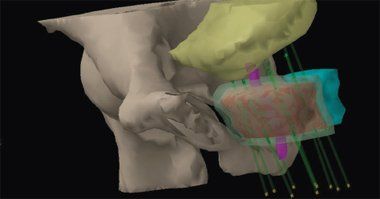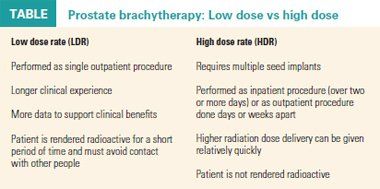Prostate brachytherapy: Guidelines assure procedural success and safeguard patients
Mismanaged therapy at one institution has dealt a blow to the field, but practitioners explain why the technique remains worthwhile.
ABSTRACT: Mismanaged therapy at one institution has dealt a blow to the field, but practitioners explain why the technique remains worthwhile.

An image from a 3D prostate cancer treatment plan created using Varian's BrachyVision treatment planning software. Image courtesy of Varian Medical Systems.
The New York Times last year uncovered a scandal about prostate brachytherapy procedures at the Veterans Affairs Medical Center in Philadelphia: A single radiation oncologist had allegedly botched more than three-fourths of the prostate brachytherapy procedures performed at the hospital during a six-year period.
Treatment problems ranged from brachytherapy seeds placed in healthy organs to inadequate radiation dose levels in patients. The article also claimed that lack of quality control and peer review at the Philadelphia VAMC allowed the errors to go undetected for six years (The New York Times, June 21, 2009).
The situation prompted a flurry of government activity: Both houses of Congress called veterans affairs committee meetings, while the Nuclear Regulatory Commission (NRC) launched its own investigation and found that the hospital had committed multiple safety violations in its prostate brachytherapy program. The NRC also looked at other prostate brachytherapy programs in the VA systems, but reported that, while the agency did identify some problems, these issues did not reach what it called "widespread programmatic breakdown that afflicted [the] VA Philadelphia."
Just last month, the NRC proposed a $227,500 fine against the U.S. Department of Veterans Affairs (VA) for violations of NRC regulations associated with errors at the Philadelphia facility.
For those who perform prostate brachytherapy, the Philadelphia VAMC case was a shocker; even the most minimal standards for performing the procedure seemed to have been ignored, such as using follow-up CT scans to view and evaluate seed placement after the procedures and calculate radiation dosages.

Still, physician-experts who testified before Congress in July 2009 were quick to point out that the Philadelphia story was the exception and not the rule. "Each year, there are approximately 50,000 brachytherapy treatments performed in the U.S." said W. Robert Lee, MD, a professor of radiation oncology at Duke University in Durham, N.C., who testified before Congress on behalf of ASTRO.
"Even with [the events that occurred within the VA], only about 0.22% of the procedures nationwide resulted in a reportable event in 2008. Brachytherapy is an extremely safe and effective procedure," Dr Lee said.
It's a point that proponents are keen to drive home: This state-of-the art, and often highly successful, treatment option should not be judged by the mistakes made at one institution. In fact, the American Brachytherapy Society (ABS) is in the process of updating its 10-year-old guidelines to reflect advances in the field.
"There is an enormous body of literature and data on thousands of patients over the last 20 years showing that patients have been successfully treated with brachytherapy in the United States and Europe," said Eric Horwitz, MD, ABS president. "The case of the Philadelphia VA highlights the need for consensus and strict guidelines."
Oncology News International spoke with Dr. Horwitz and other experts about the current state of prostate brachytherapy. They offered advice to referring physicians and their patients on how to determine if the treatment-and the physician performing the treatment-is their best bet.
"We know that our outcomes, our control of PSA, and our disease-free survival are tied to adherence to guidelines," said Nathan Bittner, MD, an ABS board member. The cases at the Philadelphia VAMC were "unfortunate, and set the field of brachytherapy back a great deal. It underscores the importance of standards in our field."
Brachytherapy basics and isotope options
Brachytherapy could never be accused of being a technology without guidelines: The ABS, the American Association of Physicists in Medicine (AAPM), and the American College of Radiology (ACR) have all published standards of care for prostate brachytherapy procedures.
The kinds of procedures that are performed today have shifted over the last 20 years with the introduction of innovations such as intraoperative planning.
"We anticipate that the [updated] guidelines will be more detailed. How we do the procedures, and what we know about prostate brachytherapy, has definitely changed over the last 10 years," said Dr. Horwitz, a professor and chair of the radiation oncology department at Fox Chase Cancer Center in Philadelphia.

Prostate brachytherapy generally falls into two categories: low dose rate (LDR) and high dose rate (HDR). LDR is still the most widely used, particularly in men who are deemed low-risk, while HDR, in combination with external-beam radiotherapy (EBRT), has historically been reserved for men with intermediate- to high-risk cancers. Both approaches have their pros and cons (see Table).
The isotopes used for prostate brachytherapy are iodine-125, palladium-103, and cesium-131. Iodine and palladium have been in use the longest; a major clinical trial comparing the two found them equivalent in terms of outcomes, Dr. Lee said, adding that "iodine has the longest track record, the energy of the isotope is a bit higher, and it's cheaper." A disadvantage of iodine is the longer half-life. So when LDR is performed, radiation precautions need to be adhered to for a longer period of time.
As for palladium, which has a shorter half-life, it's more often used in combination with other radiation therapy.

Cesium, which has the shortest half-life of all the isotopes, is being watched closely and may have the most benefits when compared with other isotopes, primarily fewer side effects. Steven Kurtzman, MD, director of prostate brachytherapy at Valley Medical Oncology Consultants in Pleasanton, Calif., said he prefers cesium for LDR prostate brachytherapy.
"[Cesium] has a higher energy than both palladium and iodine, which allows for a more homogenous dose distribution," Dr. Kurtzman said. "And it's got a shorter half-life, so patients tend to get through acute side effects much more quickly," he said.
However, Dr. Kurtzman noted that all three isotopes in use today work effectively, and which one a radiation oncologist picks is often a matter of personal choice.
Planning preferences
All HDR prostate brachytherapy is performed intraoperatively. But LDR prostate brachytherapy can be done either intraoperatively or using preplanning. Radiation oncologist preference drives that decision.

With preplanning, a volume study of the prostate to tailor dose is performed using transrectal ultrasound. The physicist and/or dosimetrist then reconstructs a 3D image of the prostate to determine the best number, activity, and placement of seeds within and around the prostate to match the radiation oncologist's prescription.
"The idea is to give the prescribed dose to the prostate gland and avoid critical structures that include the bladder, the rectum, and the urethra. Overdosing of these structures can cause real problems; for instance, a rectal fistula," said E. Brian Butler, MD, a professor and the chair of radiation oncology at Methodist Hospital in Houston. Dr. Butler said the goal is for the preplan to be reproducible in the operating room, achieving the appropriate dosimetry.
However, there are specialists who prefer the immediacy of ultrasound-based 3D intraoperative planning. "The beauty of intraoperative planning is that it's real-time, and you can monitor the dose and placement of seeds on the fly," Dr. Kurtzman said. "It insures that you deliver an appropriate dose to the prostate, and lets you monitor doses to adjoining structures more accurately. It's a more elegant way of delivering seeds."
A team approach
Unfortunately, the concept of the team approach supposedly took a sinister turn at the Philadelphia VAMC. According to the Times article, the radiation oncologist was allowed to modify clinical records to cover up serious treatment mistakes. In addition, the department is accused of having operated for years without peer review and for allowing the physician to continue to perform the procedure despite a lack of equipment necessary to calculate radiation dose.
But a good prostate brachytherapy team will draw on the expertise of many trained individuals. Led by a radiation oncologist, a team should also have a urologist, a physicist, and/or a dosimetrist. The guidelines for who is qualified to perform this procedure are quite clear: The NRC requires that a physician have 200 hours of classroom and laboratory training in radiation physics and biology and 500 hours of work experience in handling radioactive brachytherapy materials.

Most radiation oncologists receive comprehensive training in prostate brachytherapy during their residency programs, and some also take postresidency courses. While it's not a formal requirement, most experts recommend mentoring with an experienced radiation oncologist. Also, a more experienced physician should always be present when a novice begins performing procedures.
Postimplant dosimetry, as measured on CT scans, usually within one month of the procedure, is required with LDR. Because dose distribution can differ from patient to patient, the actual dose to the prostate and normal adjacent tissue over the lifetime of the implant must be documented, Dr. Lee explained. Some prostate brachytherapy specialists will perform postimplant dosimetry right after the procedure and again a few weeks afterward to make sure placement and dosage are appropriate, Dr. Horwitz said.
Selection is key
As with any procedure, prostate brachytherapy is not appropriate for all patients. The clinical practice guidelines note brachytherapy is indicated as a treatment when the target volume and tumor can be well defined. Many radiation oncologists agree that prostate brachytherapy alone is a good procedure for patients with a Gleason score of 6 or 7, a PSA of less than 10, and good urinary function.
Prostate brachytherapy is not suitable for a patient with an enlarged prostate (> 50 to 60 ccs). A larger prostate require more needles, which can lead to more swelling and serious side effects, such as inability to urinate without a catheter.
Patients with higher Gleason scores and higher PSAs can benefit from prostate brachytherapy combined with EBRT. But whether prostate brachytherapy is appropriate for high-risk patients remains a subject of debate.

"The biggest area of controversy in prostate oncology is how you treat high-risk patients," said Dr. Bittner, who is also a prostate cancer specialist with Tacoma/Valley Radiation Oncology in Washington.
He said he believes brachytherapy is an excellent treatment choice for both intermediate-risk and high-risk patients because brachytherapy allows the radiation oncologist to escalate the dose more effectively.
Experience and good outcomes count when it comes to criteria for selecting a radiation oncologist to perform prostate brachytherapy. Finding a program that is monitored and accredited by the ACR is key.
"Checking to see if a radiation oncology center is accredited is important," said Richard Hudes, MD, chief of radiation oncology at St. Agnes Hospital in Baltimore and a member of the ACR commission on radiation oncology. "Accreditation is a voluntary process, and only about 20% of radiation oncology facilities are accredited.
"Finding a radiation oncologist who does prostate brachytherapy routinely and efficiently, and is comfortable with teaching radiation safety to personnel and patients is also crucial," Dr. Hudes said.
Prolaris in Practice: Guiding ADT Benefits, Clinical Application, and Expert Insights From ACRO 2025
April 15th 2025Steven E. Finkelstein, MD, DABR, FACRO discuses how Prolaris distinguishes itself from other genomic biomarker platforms by providing uniquely actionable clinical information that quantifies the absolute benefit of androgen deprivation therapy when added to radiation therapy, offering clinicians a more precise tool for personalizing prostate cancer treatment strategies.